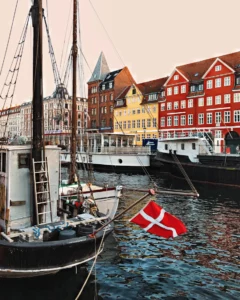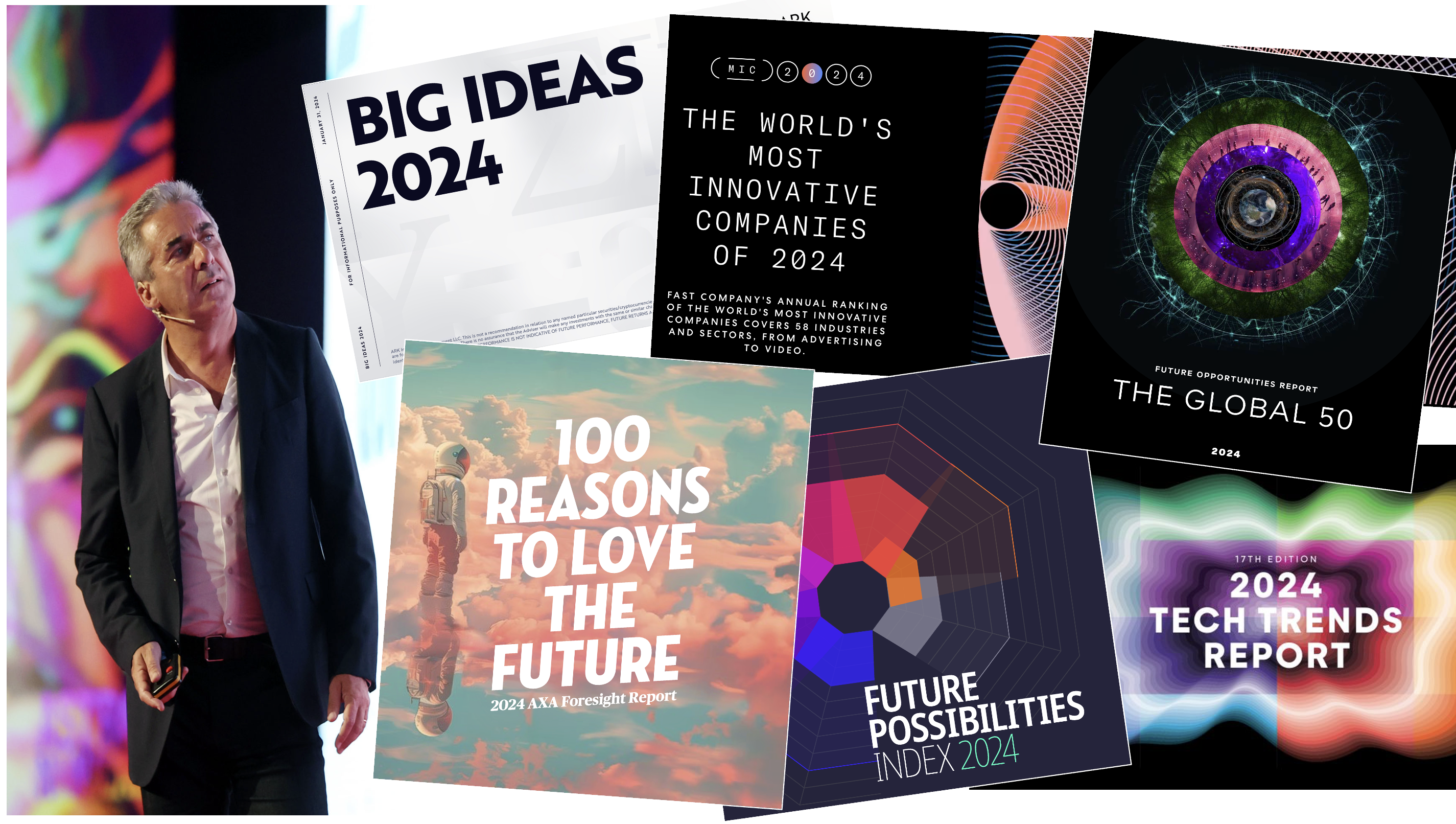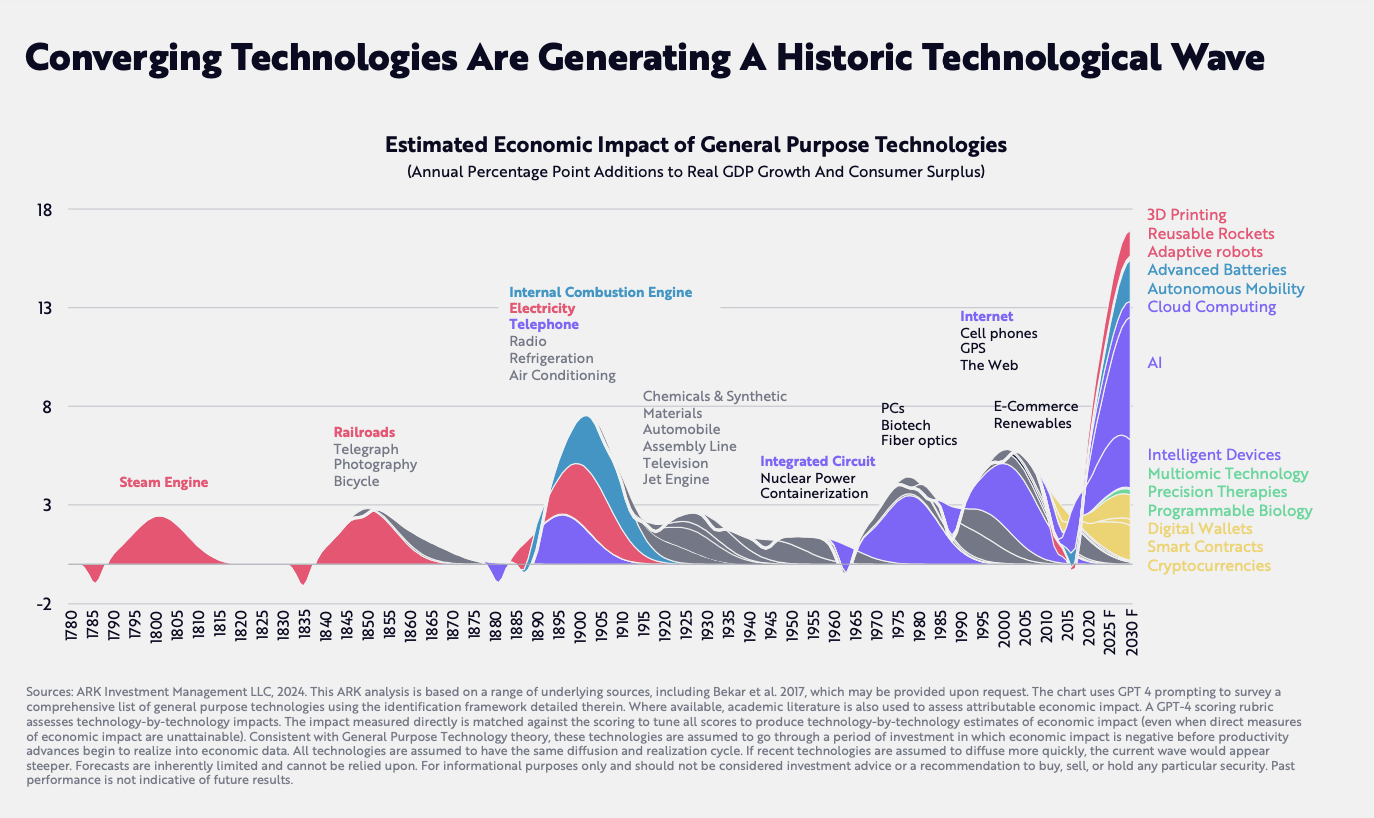Next is Now … Peter Fisk’s opening keynote at Danish ICT Forum
September 19, 2024 at IT-Branchens Lederdøgn 2024, Hindsgavl Castle, Denmark

Welcome to the future, right now.
- “Next is Now” keynote by Peter Fisk
- “CIO as Business Transformers” workshop with Peter Fisk
- Additional resources from Peter Fisk
Superfast-gaming chips and fat-busting superdrugs, asteroid-chasing rockets and carbon-capturing technologies, 4 day working weeks and chess reinvented as a reality TV game, health-enhancing fashions and the rebirth of the hairy mammoth. Nvidia is transforming tech, while Novo Nordisk innovates healthcare, KinetX changes the space race, while Climeworks eliminates carbon.
We used to marvel at innovations with a leap of imagination. Ideas and technologies that promised to transform our world, but seemed a little out of reach. Now, science fiction has collided with practical reality, powered by mind-boggling technologies that are evolving at incredible speed, but also rapid social and cultural change, accelerating human possibilities into practice.
Next is now, not only because of the pace of innovation, but also the convergence of pathways – technologies, industries, customers, applications and expectations.
What’s happening in gaming today, shapes new experiences in retail or finance. New possibilities of space travel accelerate the evolution of EVs. Clean energy meets green cement. Pharma tech meets fashion tech. Physical and digital are one, fast developing markets outpace the old stagnated developed markets, and GenZ outthink their GenX leaders.
The future is already here, even if it’s unevenly distributed. Curiosity drives creativity, enabled by new capabilities to address the biggest challenges. So what could you do? What’s your vision of next, and how do you start now?
Colossal, the de-extinction company
Colossal Biosciences seeks to reawaken the past, to bring back extinct species, to expand endangered populations through genetic rescue, to support biodiversity. In a world pushed to the brink, Colossal is optimising conservation, exogenous development, bioinformatics, modern genetics, cellular engineering, paleogenetics, biodiversity, genomics, embryology, stem cell reprogramming, computational biology, artificial intelligence, bioethics, and de-extinction.
The Austin-based genetic engineering company, founded by geneticist George Church and entrepreneur Ben Lamb, is working to de-extinct the woolly mammoth, the Tasmanian tiger, and the dodo.
Because the woolly mammoth and Asian elephant share 99.6% of the same DNA, Colossal is seeking to develop a proxy species by swapping enough key mammoth genes into the Asian elephant genome. Key mammoth genealogical traits include: a 10cm layer of insulating fat, five different types of shaggy hair, and smaller ears to help the hybrid tolerate cold weather.
Colossal launched as a fully-fledged business in 2021, with a mission to preserve endangered animals through gene-editing technology and use those same animals to reshape the world’s natural ecosystems to combat climate change.
Colossal’s lab will pair CRISPR/Cas9 with other DNA-editing enzymes, such as integrases, recombinases, and deaminases, to splice woolly mammoth genes into the Asian elephant. The company plans on sequencing both elephant and mammoth samples in order to identify key genes in both species to promote population diversification. By doing so, Colossal hopes to prevent any rogue mutations within the hybrid herd.
Back in a 2008 interview with The New York Times, George Church first expressed his interest in engineering a hybrid Asian elephant-mammoth by sequencing the woolly mammoth genome. In 2012, Church was part of a team that pioneered the CRISPR-Cas9 gene editing tool, through which the potential for altering genetic code to engineer the envisioned “mammophant” surfaced. He presented a talk at the National Geographic Society in 2013, where he mapped out the idea of Colossal.
Church and his genetics team used CRISPR to copy mammoth genes into the genome of an Asian elephant in 2015. That same year, his lab integrated mammoth genes into the DNA of elephant skin cells; the lab zeroed in on 60 genes that experiments hypothesized as being important to the distinctive traits of mammoths, such as a high-domed skull, ability to hold oxygen at low temperatures, and fatty tissue. By 2017 it had successfully added 45 genes to the genome of an Asian elephant.
While Colossal’s de-extinction business might seem like science fiction, the latest movie from Jurassic Park, it echoes the progress by companies like CRISPR Therapeutics in Zurich, led by Nobel prize winner Jennifer Doudna, who applying the same science to humans. With all the same technical and ethical challenges which it brings. It also demonstrates how rapidly ideas of fiction are now becoming reality.

- Big Ideas Report 2024 … how tech is transforming business
- Future Possibilities Index 2024 … the next economies emerging right now
- Global 50 Opportunities 2024 … megatrends driving new opportunities
- 100 Reasons to Love the Future … new narratives that give hope amidst uncertainty.
Innovations enabled by incredible technologies
The new Big Ideas report by ARK Invest captures the disruptive impact of technologies right now. It suggests that by 2030, the convergence of 5 significant technologies, accelerated by artificial intelligence, will have an unprecedented economic impact. AI provides the “intelligent glue” to bring together the potential of public blockchains, multigenomic sequencing, energy storage, and robotics, in a way that could transform global economic activity more significantly than any previous industrial revolution.
Globally, real economic growth could accelerate from 3% on average during the past 125 years to more than 7% during the next 7 years as robots reinvigorate manufacturing, robotaxis transform transportation, and AI amplifies knowledge worker productivity.
As a result the global equity market value specifically associated with disruptive innovation could increase from 16% of the total to more than 60% by 2030, resulting in annualised equity returns of 40%, or increasing the total market capitalisation driven by disruptive tech from $19 trillion today to roughly $220 trillion by 2030.

The Future Possibilities Index 2024 also explores the applications of these fast-emerging tech, and how they will shape new economies. It focus on 6 transformational trends that are creating possibilities and the factors that determine our readiness and capacity to leverage these trends over the next 5-10 years. All have emerged from a combination of new business models, technologies, and changes in attitudes and behaviours. The six trends are the Exabyte Economy, the Wellbeing Economy, the Net Zero Economy, the Circular Economy, the BioGrowth Economy and the Experience Economy.
Fast Company’s latest ranking of the world’s Most Innovative Companies 2024 showcases some of the most exciting innovators who are both driving this tech acceleration, and embracing its benefits. While BCG also produces an innovation ranking each year, quantitatively evaluating the R&D efforts of corporations, the FC version is far more insightful, about the people driving the innovations, and the solutions that are emerging.
This year’s #MIC24 ranking includes:
- Nvidia is riding a wave of warp-speed AI progress, having lagged far behind Intel for decades, Jensen Huang’s $1.5 trillion business which he founded in 1993 on his 30th birthday, leapt ahead of tech monoliths like Alphabet and Amazon in recent months, driven by the rush for high-powered immersive gaming, and the relentless growth of AI.
- Novo Nordisk found in its latest diabetes drug Ozempic, an obesity-busting sensation, that together with its lower dosage sister-brand Wegovy, has taken the world by storm. The Danish pharma business can’t make enough of it, and has soared to become Europe’s most valuable company, and more valuable than Denmark’s entire GDP.
- Perplexity is creating an entirely new way to search the web, by leveraging AI to provide more contextualised and accurate answers, rather than a list of relevant links. It uses a combination of homegrown large language models (LLMs) and third-party models (like OpenAI’s GPT-4) plus retrieval-augmented generation (RAG).
- KinetX helped navigate a spacecraft on a 4.4 billion-mile mission to land on an asteroid and return home. Founded in 1992 as a spinoff of Lockheed Martin, it is partnering NASA on deep-space missions like New Horizons (to Pluto, then the edge of the solar system) and Messenger (orbiting Mercury for the first time).
- Climeworks uses direct air capture to scrub carbon from the atmosphere. It operates the world’s largest DAC plants, both in Iceland, which remove around 10,000 tons of CO2 from the atmosphere every year—and about half of that is being done by the Zurich-based DAC pioneer.
Innovations enabling radically better lives
The new Global 50 Opportunities report by Dubai Future Foundation takes a global perspective on the innovative applications emerging from a rapidly changing world, partly driven by technologies, but much more too.
It starts by exploring the megatrends which it sees as most influential right now, and then how these are unlocking 50 opportunities for future growth, prosperity and well-being. Some opportunities may be in their early days of exploration, some require reflection, and some feel very far away. “Shaping the future cannot be done by just waiting for it but rather by utilizing the latest technologies and knowledge tools and meeting its challenges starting from today.”
The 8 megatrends include materials revolution (from which opportunities emerge like 3d printing of human organs, green plastics, and fashion with embedded health benefits), future humanity (school for wisdom, open source science, and flipping career ladders), and advanced health (mental AI, pulse over pills, and biohacking 2.0). These are just a few examples (dive into the digital report to explore the opportunities in more detail):

100 Reasons to Love the Future is a fabulous new report from AXA’s foresight team, promising “new narratives of hope” and inspiring us to “imagine utopia rather than retreat to dystopia”. The report argues that in a world of escalating risks, our societies and economies cannot afford to become paralysed by uncertainty. We are all living through a deep transformation. Far better to embrace it than retreat into anxiety and doubt.
In the midst of the 100 reasons is a great insight from Plurality University about what organisations could look like in 2050 – from the Marketrix to the Reactivator, the Enterpocine and the Zombinc. There’s also a great insight about Te Korekoreka, and navigating futures with Māori Wisdom. The New Zealand initiative uses social innovation to achieve equity in education, employment, and income for Māori people. And much more, a great report!
Take another look at Fast Company’s Most Innovative Companies 2024 list, and beyond the big names like Nvidia you will find a wealth of smaller companies making significant human impacts, harnessing tech for good, rather than just for tech. Yet the new tech capabilities are incredible, providing new ways to solve some of the biggest problems; while also shaping cultures through exponential social influence; and enabling people to access, and do, what they could never before:
- Solfácil the Brazilian solar investment company is bringing solar power to people living in the Amazon, and has financed approximately $450 million in solar loans, working with more than 4,250 active solar installers and has 66,000-plus customers to date.
- 4 Day Week Global convinced companies around the world to adopt a shorter work week, the nonprofit brought together hundreds of companies to create a post-pandemic revolution in the workplace, encouraged by its research which showed that a 4 day week delivered an average 36% rise in revenue.
- Chess.com is turning a centuries-old game into must-see reality TV. The freemium chess platform logged more games played (12.5 billion) than ever before, while establishing itself as the game’s cultural hub, full of everything from news to memes to the best Twitch streamers.
- Sea Forest, a Tasmanian business which scooped the 2023 Earthshot Prize, has a seaweed supplement to stop cows from burping up methane. It is the first company in the world to farm methane-busting Asparagopsis, a red seaweed native to Australian coastal waters, reducing methane production by up to 90%.
- Mattel took its 65 year old Barbie dolls and turned the brand into a $1.4 billion global movie blockbuster, the highest grossing film of 2023, with a series of agenda-setting messages not just saccharine sassiness, and became a cultural event that attracted diverse audiences, plus all types of pink-coloured spinoffs.
So while the world of technology is complex and relentless, with profound questions about ethics and humanity, our rapidly changing world can also be deeply human, sometimes frivolous, sometimes profound.
The opportunities to innovate are everywhere. And while average, old markets might seem to have stagnated, the world continues to move forwards at incredible pace. We have huge challenges, where issues like climate change will only be conquered with radical new thinking, and enabled by new technologies.
We also have an opportunity to create a happier, healthier world. Embrace utopia, don’t retreat to dystopia. By jumping to the future we can see problems differently, the impossible becomes possible, and we can accelerate progress.
Denmark, let’s create a better future, together
Danes are brought up to question authority, which makes them powerful innovators. This small country is constantly coming up with revolutionary approaches to design, environmental science, pharmaceuticals, biomedicine, food, agriculture, and many different types of technology.
From the time they are children, Danes are told to question conventional wisdom – and encouraged to come up with something better. That makes innovation and entrepreneurship a natural part of the Danish DNA. An economic system that encourages business risks and provides a social safety net helps too.
Danish design has been an international standard-bearer since the 1950s, and always-evolving industries like healthcare and pharmaceuticals also play a substantial role in the Danish economy. These days, Danish innovators are leaders when it comes to sustainability and green living.
Here are just a few of my favourite Danish innovators, shaking up their industries, and the world, right now:
- Arla Foods, reinventing farming to packaging, flavours and foods
- Bjarke Ingels Group, architectural boldness and regeneration
- Coloplast, medical devices from ostomy, and urology, to wound care
- Danfoss, everything from energy to hydraulics, pumps and valves
- Flying Tiger Copenhagen, retail simplicity and novelty, that’s fun
- Just Eat, a global lead in food delivery services, grown worldwide
- Maersk, harnessing blockchain to reinvent global supply chains
- Mikkeler, the world’s largest craft beer brand, and running club
- Novonesis, merged biosciences giant, from enzymes to probiotics
- Novo Nordisk, a disciplined focus on diabetes, and now obesity
- Orsted, global clean energy pioneer, transformed from the old Dong
- Trustpilot, giving consumers confidence in an online retail world
- Universal Robotics, pioneering the rise of cobots and more
- Zendesk, software as a service, embracing AI to revolutionise service
At this year’s event, I will be exploring what it really takes to create a better future.
- Having optimism to seize the best new opportunities in a fast-changing world
- Asking the big questions, making new connections, having bolder ambition
- Technologies, and CTOs (also CIOs), as the catalysts and enablers of change
- Starting from the future back, with a bolder vision, and now forwards roadmap
- Transformation as the leadership superpower to create better, and accelerate change
- Now is the moment. Time to step up, disrupt yourself, inspire others, and achieve more.
Where are the biggest opportunities in a world of uncertain yet frenetic change? How can companies harness the power of collective innovation through clusters and ecosystems for faster and more remarkable impact? And how can business and society work better together to create a sustain a world where we all want to live, and where we can all thrive?
Next is now. There is only ever today. Let the future begin.
Explore more
- 24 for 2024 … new ideas, new innovators, new possibilities
- Future Recoded … an online learning and knowledge platform
- Trend Kaleidoscope 2024 … curating all the best trend reports
- Megatrends and Strategies … defining your future strategy roadmap
- Waveriders and Transformers … developing leaders as future makers
Find out more and book >